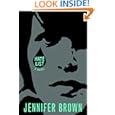
Thank goodness for a power outage! Without it, this book would still be sitting on my shelf waiting to be finished (don't worry- it had many friends there). Shiver, by Maggie Stiefvater, is just the thing you need to get you over those Twilight cravings. It is full of star-crossed romance, mystical creatures, and a story you cannot get enough of. While it is indeed a book about a pack of werewolves, Shiver is nothing like Jacob and the Twilight pack.
The Shiver wolves do shift between man (or woman) and wolf, but they turn into actual wolves- not the creepy man/wolf combination. The wolves cannot shift at will, but are actually at the mercy of the weather. When it gets cold, they turn into wolves for the winter. In the summer they stay in their human forms. The catch is that the longer they have been werewolves, the shorter the time they will stay human until they become permanent wolves. This final change is what Grace and Sam are dreading.
Sam is a wolf nearing the end of his human years. Grace is a girl in high school who was attacked and bitten by the wolves when she was young. The only thing that saved her was Sam. He stopped the wolves, but knew she had been bitten and would turn. Even though she didn't actually turn, Sam waited for her each and every year- in the winter as a wolf outside her house and in the summer as a boy in town. When a local boy is attacked by the wolves and mysteriously disappears from the morgue, the townspeople decide to take care of the wolf pack once and for all with a hunting party. Grace is terrified for her wolf (who she doesn't know is Sam) and races into the woods to stop it. After she finally succeeds in halting the hunters, they send her back to her house where she finds Sam on her porch, naked, shot, and with the same haunting eyes of her wolf- the wolf who saved her all those years earlier.
This starts a romance that must race against time. With winter fast-approaching, Sam and Grace try everything to keep Sam human, but it can't last forever. This is Sam's last year as a person and he does not want to lose Grace now that he finally has her. With rogue wolves, erratic and angry new wolves, and her friends and family in danger, Grace fights a long autumn.
This book is a fantastic new take on the werewolf sensation. You find yourself drawn to the wolves and their "family" while still wishing Sam could just stay human for Grace. With enough action to please the masses and enough sweet, devoted romance to make the ladies swoon, this is a great book! And the best part? The sequel is coming soon (although not nearly soon enough for me)! So give Shiver a chance and don't forget to snag Linger on July 20, 2010:












